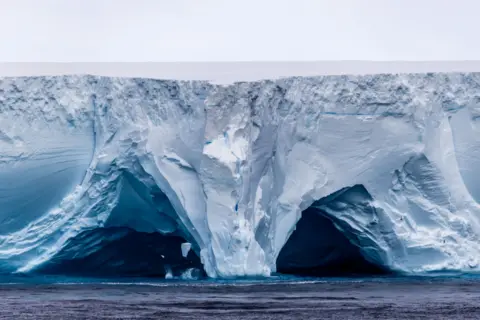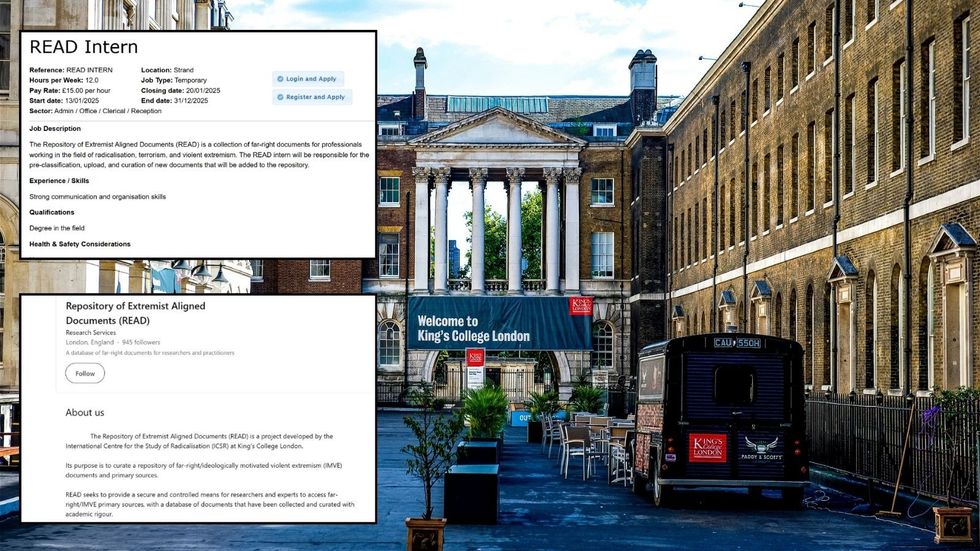NewsBeat
A23a: Giant iceberg on collision course with island

Climate and science reporter
Data journalist
 Getty Images
Getty ImagesThe world’s largest iceberg is on a collision course with a remote British island, potentially putting penguins and seals in danger.
The iceberg is spinning northwards from Antarctica towards South Georgia, a rugged British territory and wildlife haven, where it could ground and smash into pieces. It is currently 173 miles (280km) away.
Countless birds and seals died on South Georgia’s icy coves and beaches when past giant icebergs stopped them feeding.
“Icebergs are inherently dangerous. I would be extraordinarily happy if it just completely missed us,” sea captain Simon Wallace tells BBC News, speaking from the South Georgia government vessel Pharos.
 BFSAI
BFSAIAround the world a group of scientists, sailors and fishermen are anxiously checking satellite pictures to monitor the daily movements of this queen of icebergs.
It is known as A23a and is one of the world’s oldest.
It calved, or broke off, from the Filchner Ice Shelf in Antarctica in 1986 but got stuck on the seafloor and then trapped in an ocean vortex.
Finally, in December, it broke free and is now on its final journey, speeding into oblivion.
The warmer waters north of Antarctica are melting and weakening its vast cliffs that tower up to 1,312ft (400m), taller than the Shard in London.
It once measured 3,900 sq km, but the latest satellite pictures show it is slowly decaying. It is now around 3,500 sq km, roughly the size of the English county of Cornwall.
And large slabs of ice are breaking off, plunging into the waters around its edges.
A23a could break into vast segments any day, which may then hang around for years, like floating cities of ice cruising uncontrollably around South Georgia.

This isn’t the first huge iceberg to threaten South Georgia and Sandwich Islands.
In 2004 one called A38 grounded on its continental shelf, leaving dead penguin chicks and seal pups on beaches as massive ice chunks blocked their access to feeding grounds.
The territory is home to precious colonies of King Emperor penguins and millions of elephant and fur seals.
“South Georgia sits in iceberg alley so impacts are to be expected for both fisheries and wildlife, and both have a great capacity to adapt,” says Mark Belchier, a marine ecologist who advises the South Georgia government.
Sailors and fisherman say icebergs are an increasing problem. In 2023 one called A76 gave them a scare when it came close to grounding.
“Chunks of it were tipping up, so they looked like great ice towers, an ice city on the horizon,” says Mr Belchier, who saw the iceberg while at sea.
Those slabs are still lingering around the islands today.
“It is in bits from the size of several Wembley stadiums down to pieces the size of your desk,” says Andrew Newman from Argos Froyanes, a fishing company that works in South Georgia.
“Those pieces basically cover the island – we have to work our way through it,” says Captain Wallace.
The sailors on his ship must be constantly vigilant. “We have searchlights on all night to try to see ice – it can come from nowhere,” he explains.
A76 was a “gamechanger”, according to Mr Newman, with “huge impact on our operations and on keeping our vessel and crew safe”.
 Simon Wallace
Simon WallaceAll three men describe a rapidly changing environment, with glacial retreat visible year-to-year, and volatile levels of sea ice.
Climate change is unlikely to have been behind the birth of A23a because it calved so long ago, before much of the impacts of rising temperatures that we are now seeing.
But giant icebergs are part of our future. As Antarctica becomes more unstable with warmer ocean and air temperatures, more vast pieces of the ice sheets will break away.

Before its time comes to an end though, A23a has left a parting gift for scientists.
A team with the British Antarctic Survey on the Sir David Attenborough research vessel found themselves close to A23a in 2023.
The scientists scrambled to exploit the rare opportunity to investigate what mega icebergs do to the environment.
 Tony Jolliffe/BBC
Tony Jolliffe/BBCThe ship sailed into a crack in the iceberg’s gigantic walls, and PhD researcher Laura Taylor collected precious water samples 400m away from its cliffs.
“I saw a massive wall of ice way higher than me, as far as I could see. It has different colours in different places. Chunks were falling off – it was quite magnificent,” she explains from her lab in Cambridge where she is now analysing the samples.
Her work looks at what the impact the melt water is having on the carbon cycle in the southern ocean.
 Getty Images
Getty Images“This isn’t just water like we drink. It’s full of nutrients and chemicals, as well as tiny animals like phytoplankton frozen inside,” Ms Taylor says.
As it melts, the iceberg releases those elements into the water, changing the physics and chemistry of the ocean.
That could store more carbon deep in the ocean, as the particles sink from the surface. That would naturally lock away some of the planet’s carbon dioxide emissions that contribute to climate change.
Icebergs are notoriously unpredictable and no-one knows what exactly it will do next.
But soon the behemoth should appear, looming on the islands’ horizons, as big as the territory itself.
NewsBeat
Creator of fake video of MLA Cara Hunter has not been found

A Stormont politician has said the person who created a false pornographic video of her has yet to be found.
Cara Hunter of the Social Democratic and Labour Party was targeted in a deepfake video three years ago, when her face was digitally superimposed on to the face of another person.
The video was circulated widely on WhatsApp and social media in the run up to the 2022 Stormont elections.
A deepfake is an image or video that has been digitally altered with the help of artificial intelligence to replace the face of one person with the face of another.
Hunter has since campaigned for a change in the law that would see the creation of deepfake images to be made a criminal offence in Northern Ireland.
Speaking to BBC Radio Foyle’s North West Today programme, the assembly member for East Londonderry said while the Police Service of Northern Ireland was “very sympathetic”, it was unable to take the matter further due to the “lack of appropriate laws here and also a lack of investment in cybercrime technology”.
“What’s very sad is that we’re now almost three years on from what happened to me and, right now, the same thing could happen again – to any woman, to any child, to any man,” said Hunter.
“There’s a real sinister use of this technology and if someone does it to you, you want to know who has that level of anger or angst or resentment towards you that they would make something such as this.”
Hunter added that deepfakes were “extremely convincing” and she still did not know who targeted her.
She appealed to anyone with information to come forward and also appealed to the Department of Justice (DoJ) to invest more in tackling cybercrime.
“I’ve looked at the models of other countries, especially across Europe, and how they approach victims of deepfake technology and they’re far further ahead,” she said.
“In Germany, they have AI [artificial intelligence] centres, which look at AI innovation but also supporting people who have been deepfaked and enabling them to have guidance and support.
“We don’t have anything like that here.”
She previously told the Belfast Telegraph that the experience had been “the most horrific and stressful time of my entire life” and that it still affected her mental health three years on.
Later in January, Hunter will feature in a Channel 4 documentary about the issue with TV presenter Vicky Pattison.
I’m A Celebrity winner and former MTV Geordie Shore star Ms Pattison “directed and produced” a deepfake video featuring herself as part of the documentary.
The DoJ has been contacted for a response.
NewsBeat
Real Madrid become first club to earn one billion euros after new sponsor and winning Champions League | World News

Real Madrid have become the first football club to generate more than a billion euros (£845m) in revenue in a single year, topping a financial services company’s league.
Winning both LaLiga and the Champions League last season, Deloitte said the Spanish club had overtaken Manchester City to reclaim top spot in its Football Money League.
Real Madrid also saw matchday revenues increase in 2023/24 – after renovations to the Bernabeu Stadium – doubling to €248m (£209m).
The club also saw a 19% increase in commercial revenue from a new sleeve sponsorship from HP and increased merchandise sales – bringing in another €482m (£407m)
All in, Real Madrid recorded €1,045bn in revenue in the 2023/24 season, putting it well ahead of City which recorded €837m (£707m).
In third place was Paris St Germain, the only French side in the top ten, which recorded a revenue of around £680m.
Despite finishing seventh for their worst-ever season in the Premier League, Manchester United placed fourth at around £650m, ahead of Bayern Munich at £646m and Barcelona at £642m.
Arsenal were seventh with revenues of £605m, narrowly ahead of Liverpool at £603m. Tottenham Hotspur meanwhile placed ninth at £519m, and Chelsea rounded off the list with £460m in earnings.
Deloitte said taking part in UEFA competitions was vital for club revenues, noting that the Italian side Juventus fell from 11th to 16th in their rankings after being excluded from European fixtures over breaches of financial fair play rules.
Read more:
Haaland signs nine-and-a-half-year deal with Man City
Angel City FC founder eyes stake in Chelsea women’s team
Tim Bridge, lead partner in the Deloitte Sports Business Group, added: “While commercial revenue dominates the income of the top 10 Money League clubs, broadcast income remains crucial for teams in the second half of the rankings.
“As competitions expand and create more broadcast and matchday opportunities, these can further increase the earning potential for clubs.”
Politics
King’s College University scolded after splurging taxpayers’ money on ‘Far-Right extremism’ probe

King’s College London has been criticised for “clear evidence of bias” after spending taxpayer money investigating Far-Right extremism while failing to research the Far-Left.
The university hosts the Repository of Extremist Aligned Documents (Read), which is described as a “collection of Far-Right documents for professionals working in the field of radicalisation, terrorism, and violent extremism”.
A job description for a recently advertised internship in Read, seen by GB News, says the successful applicant will focus on scrutinising extremism on the political Right, with no similar roles for investigating the actions of extremists on the other end of the spectrum.
The Read advert states the intern will source information from Far-Right forums, chat sites, Telegram channels, and websites.

King’s College London has been criticised for ‘clear evidence of bias’ after spending taxpayer money investigating Far-Right extremism while failing to research the Far-Left
GB News/ Getty
Critics have warned the role appears politically motivated and one-sided.
Conservative MP and Shadow Home Secretary Chris Philip told GB News: “This shows clear evidence of bias.
“Why would a supposedly neutral institution target only one kind of extremism?”
Philip questioned why the higher education institution appeared to be “ignoring the Far-Left”, adding: “This university has questions to answer about balance and impartiality.”
Reform UK MP Rupert Lowe said: “Sadly the educational Establishment has been undermined by a left-wing bias and what they describe as Far-Right is what most of us call normal.”
LATEST DEVELOPMENTS:
The International Centre for the Study of Radicalisation (ICSR) at King’s College London, which created Read, has published numerous reports on the Far-Right but does not appear to have published any research into Far-Left extremism.
Protect UK, a British Counter-Terrorism Alliance partnership, has assessed the threat from Left-Wing motivated extremism is low.
However, it points to a number of examples of terror threats in the UK and Europe in recent years which are thought to have been linked to the political Far-Left.
Europol has previously confirmed that in 2020 alone there were 24 Left-Wing or anarchist attacks in the European Union.

The Read advert states the intern will source information from Far-Right forums, chat sites, Telegram channels, and websites
GB News

A job description for a recently advertised internship in Read, seen by GB News, says the successful applicant will focus on scrutinising extremism on the political Right, with no similar roles for investigating the actions of extremists on the other end of the spectrum
GB News
In recent years there have also been two foiled Left-Wing plots in the UK, one of which resulted in a man being arrested for possessing a crossbow, bolts, a machete, and body armour in 2019.
Former immigration minister Kevin Foster slammed King’s College London for being “blindsided” by the Far-Left, warning: “It’s vital we are alive to the risks of all who seek to subvert our freedoms, whatever political cover they use for this.”
He added: “I hope King’s will decide they must tackle both sides of the coin when it comes to extremism, not just look at one.”
King’s College London did not respond when approached for comment by GB News.
Politics
POLL OF THE DAY: As the economy struggles


UK public borrowing surged to £17.8billion in December, marking the highest December borrowing in four years.
The figure came in 25 per cent above economist predictions, according to data released by the Office for National Statistics (ONS).
The unexpected increase in borrowing costs has raised concerns about the state of public finances, despite Chancellor Rachel Reeves maintaining confidence in the country’s financial health following the October budget.
The significant rise was primarily attributed to high debt interest costs and a one-off military housing purchase. The December borrowing figure represents a £10.1billion increase compared to the same period last year.
Economists had forecast public sector net borrowing would reach £14.1billion for the month.
The market pressures come amid recent financial turbulence, with the pound falling to a nine-month low against the dollar two weeks ago. UK 10-year borrowing costs have climbed above 4.8 percent.
The yield on 30-year gilts has reached 5.36 percent, its highest level since 1998.
The Chancellor’s £9.9billion fiscal headroom is at risk of being completely erased, according to economic experts.
With that in mind, as the economy struggles – Should Rachel Reeves prioritise reducing debt or economic growth? Vote in our poll and have your say by commenting below.
NewsBeat
Oxfam report: Britain should give India back its artefacts in lieu of £52trn in colonialism reparations, says historian

A historian has suggested Britain return looted artefacts to its former colonies instead of vast sums in reparations, after an Oxfam report suggested India was owed over £52 trillion.
The report suggested that Western nations commit to providing former colonies with at least £4 trillion annually in reparations and “climate debt” – a sum reflecting the costs developed economies owe poorer nations for climate change.
The report, titled Takers not Makers: The Unjust Poverty and Unearned Wealth of Colonialism, said: “Oxfam calculates that between 1765 and 1900, the richest 10 per cent in the UK extracted wealth from India alone worth US$33.8 trillion (£27.38 trillion) in today’s money.”
It added that “this would be enough to carpet the surface area of London in £50 notes almost four times over”.
The figure of $64.82 trillion (£52.58 trillion) was not calculated by the report’s authors but was attributed to two Delhi-based Indian economists, Utsa Patnaik and Prabhat Patnaik.
“Reparations must be made to those who were brutally enslaved and colonised,” the report read. “Our modern-day colonial economic system must be made radically more equal to end poverty. The cost should be borne by the richest people who benefit the most.”
Rana Safvi, a leading Indian historian and author, questioned the practicality and implications of such large sums in monetary reparations. She told The Independent that there were concerns about the complexity of addressing historical wrongs and the risk of opening a Pandora’s box, considering the vast scale of past injustices worldwide.
“What they can actually return are the artefacts, the jewellery, the documents, the manuscripts, the paintings, all that has been looted from India should definitely be sent back,” she said. “Not just India, you know – all these museums all over the Western world are populated by things from Africa and Asia only.
“While the return of money may be chasing a fool’s dream, repatriating artefacts and treasures illegally taken from India is necessary and achievable.”
The Oxfam report drew sharp criticism from some other academics. Prof Lawrence Goldman, of St Peter’s College, Oxford, was quoted as saying by The Telegraph: “Oxfam depends on public trust in the accuracy of information it provides. Producing bogus history warped by ideology hardly encourages anyone to dig deep in their pockets and send them cash.”
He added: “There’s a reverse argument in which Indians should pay Britain for saving them from becoming part of the French overseas empire in the 18th century or being swallowed by Tsarist Russia in the 19th century, or being overrun by the Japanese in the 20th century, all of which were real threats.
“But arguments of this type, in which history becomes ammunition for a political assault, are worthless.”
An Oxfam spokesperson told The Independent: “Putting an exact figure on the cost of colonialism to countries like India will always be a source of debate. We believe the figure we quoted in the report is a reasonable one, but other estimates can be made.
“However, very few would dispute that Britain derived a significant financial benefit from its empire and its colonisation of India in particular, and that these benefits accrued mainly to the richest people in the UK at the time.”
The report said that in 2024 billionaire wealth grew three times faster than in 2023, with five trillionaires projected within a decade. Meanwhile, crises of economy, climate, and conflict mean the “number of people living in poverty has barely changed since 1990”.
Most billionaire wealth – 60 per cent – stems from inheritance, corruption, or monopoly power, Oxfam said. It said that the world’s inequality has roots in colonialism, which enriched the wealthy while exploiting marginalised groups, including women and racialised communities.
“This exploitation of people worldwide drove an explosion of wealth for rich people in rich countries and contributed to deep inequality in the Global South, often favouring an elite few at the expense of the many.”
The “Takers not Makers” report said this legacy persists, as wealth continued to flow from the Global South to the Global North at a rate of $30m (£24.5m) per hour. It noted that to address this imbalance, reparations for colonial exploitation and systemic reforms targeting the wealthiest are necessary to achieve equality and end poverty.
“Reparations to the victims must be made to ensure restitution, provide satisfaction, compensate for damages incurred, ensure rehabilitation and prevent future abuses,” it said.
An Oxfam spokesperson added: “Along with many other scholars and activists, we believe it is reasonable to ask the richest countries to pay reparations for the harm done by colonialism. It’s not about asking individuals who are already struggling to pay for the wrongs of the past, reparations should be financed by those who continue to profit from these systems, such as the wealthiest individuals and corporations, not ordinary people.”
“We are not saying that colonialism is the sole driver of inequality; other causes include monopoly power and cronyism and corruption. But colonialism, both historically and in the modern day is a crucial factor that must be addressed to create a more equitable future for all,” they said.
Oxfam International executive director, Amitabh Behar, said: “The capture of our global economy by a privileged few has reached heights once considered unimaginable. The failure to stop billionaires is now spawning soon-to-be trillionaires. Not only has the rate of billionaire wealth accumulation accelerated – by three times – but so too has their power.”
He added: “The crown jewel of this oligarchy is a billionaire president, backed and bought by the world’s richest man Elon Musk, running the world’s largest economy. We present this report as a stark wake up-call that ordinary people the world over are being crushed by the enormous wealth of a tiny few.”
Oxfam also suggested that governments cap top incomes, tax the rich, abolish tax havens, and reverse wealth flows from the Global South. “Inheritance needs to be taxed to dismantle the new aristocracy,” it said.
“Former colonial powers must also confront the lasting harm caused by their colonial rule, offer formal apologies, and provide reparations to affected communities,” the statement said.
NewsBeat
Sealed with a kiss: Same sex couples in Thailand celebrate equal marriage rights | World News

Hundreds of same-sex couples have been tying the knot in Thailand today as it becomes by far the largest nation in Asia to allow equal marriage and the first in South East Asia.
A mass LGBTQ wedding at a shopping mall in Bangkok saw hundreds of marriage registrations as the law came into effect. It marked the culmination of years of campaigning and thwarted attempts to pass equal marriage laws.
Porsch Apiwatsayree and Arm Panatkool have been together for 17 years, but first got engaged 11 years ago.
“Personally, I think it marks the beginning of equality in Thailand and it also, in a way, inspired people to see that love is normal,”Porsch said, holding his hand on his heart. “Every love is the same, every love is the same inside.”
Thailand’s same-sex marriage bill was passed in an historic parliamentary vote last June, making Thailand the third country in Asia to do so after Taiwan and Nepal.
Thailand ranks highly on global assessments of LGBTQ legal conditions and public attitudes. It’s very different from many of its neighbours where most nations oppose gay rights. Opinion polls have also shown overwhelming public support for equal marriage.
But the kingdom remains a conservative Buddhist society with a largely patriarchal family structure.
‘Love is just love’
Porsch and Arm still believe it has some way to go to ensure tolerance translates to full acceptance.
“We have to wait and see because even the law has approved that love is the same. We need more and more acceptance,” Porsch said.
His own wedding to Arm was celebrated in the grounds of a luxurious new shopping centre. The families of both grooms played a huge part in the ceremony, lining up to face each other in a humorous and moving Thai custom of call and response between each party.
“What I feel now is the closeness between people and families,” said Porsch.
“Love is just love,” Arm added, with a beaming smile.
NewsBeat
Urgent supermarket recall of cough syrups in middle of flu season

Supermarkets have issued an urgent recall of batches of cough syrup which they fear may have been contaminated.
One customer found foreign material in their medicine sparking the move with users urged to check bottles going back as far as September 2022.
The notice applies to certain batches of Tesco Health Dry Cough Relief 200ml, Asda Strong Dry Tickly Cough 200ml, Almus Dry Cough Relief and Bells Dual Action Dry Cough.
A UKHRSA spokesman said: “Bells Healthcare is recalling the listed batches of dextromethorphan hydrobromide BP containing products as a precautionary measure, due to foreign material detected in some bottles.
“The contamination was identified by a single customer complaint and the investigation and analysis remains ongoing. Bells Healthcare is taking precautionary action to recall the potentially impacted batches at Retail, Pharmacy and Wholesaler level and this issue may impact a number of different liveries, as listed in this notification.”
Retailers were warned to stop supplying the listed batches immediately and quarantine all remaining stock and return it.
Patients were told to be vigilant for any visible contamination and contact a healthcare professional if they have any concerns.
The notice added: “Patients who experience adverse reactions or have any questions about the medication, should seek medical attention. Any suspected adverse reactions should also be reported via the MHRA Yellow Card scheme.’
The recall came after Lidl issued an urgent recall of infected cheddar cheese over fears it can cause flu-like symptoms and severe infections to babies, the elderly and pregnant women.

Some Deluxe Sriracha Cheddar Cheese Wedges, sold in branches of the budget supermarket in Northern Ireland, were found to contain a dangerous bacteria called Listeria monocytogenes.
The batches of the spicy cheese being recalled have a best before date of May 5, Lidl said in posters being put up in affected stores.
NewsBeat
Waitrose to bring back free perk that had shoppers queuing around the corner

Waitrose has heard the calls from their loyal customers and is set to bring back free hot drinks for shoppers – even if they do not buy anything in store.
The upmarket supermarket has told members of its loyalty scheme that from 27 January, they can get one complimentary drink per day if they use a reusable cup.
The perk – which entitles customers to a free americano, cappuccino, latte, or tea – was first introduced in 2013.
Four years later, the terms changed to only allow customers who had shopped in store to bag a free drink. The scheme was completely scrapped during the pandemic but was slowly being reintroduced by Dame Sharon White, the former chair of the John Lewis Partnership.
A spokesperson for Waitrose said: “Some of our members like to have their free coffee before or during their shop, rather than afterwards, so we are just offering a bit of flexibility in response to customer feedback.”
“In practice, lots of customers do this already, so this is just a formality as part of updated T&Cs.”

To claim from a free drink from a store’s self-service machine, you must bring your own cup and be a MyWaitrose member – which you can sign up for free for online.
An email sent to members of its loyalty scheme read: “You’ll be able to get your free hot drink without buying anything in store first. Don’t forget your reusable cup!”
The move comes after it was revealed in November that high-street rival M&S had overtaken Waitrose in market share for the first time outside the Christmas period.
Jason Tarry, a former Tesco chief executive, took charge as new Waitrose chairman last autumn and is perhaps trying to regain ground with middle-class shoppers.

When the free drink perk was first introduced, the perk drew the attention of politicians including from the then Labour shadow communities minister, Andy Sawford, who asked MPs to write to the firm in 2014.
He believed the scheme would take away from small firms and “further destroy the British high street”.
Waitrose also offers free hot drinks to members of the police in what the company said was s part of an initiative to cut down on shoplifting”.
When it was introduced in August 2023, West Mercia Police Federation secretary Pete Nightingale said: “It makes sense from a business perspective because any police presence is bound to have an impact – either as a reassurance for shoppers or a deterrent for shoplifters.”
NewsBeat
Bloc may consider UK joining pan-Europe customs area

The new European Union trade chief responsible for post-Brexit negotiations has told the BBC that a “pan-European [customs] area is something we could consider” as part of “reset” discussions between the UK and EU.
Maros Sefcovic was referring to the idea, backed by some UK business groups, of Britain joining the Pan-Euro-Mediterranean Convention (PEM).
The PEM allows manufacturers to use parts or ingredients from dozens of countries, from Iceland to Turkey, in tariff-free trade.
The previous Conservative government chose not to pursue PEM as part of its post-Brexit trade deal, but some businesses say it will help Britain rejoin complex supply chains that have been hit by customs barriers.
Speaking at the World Economic Forum in Davos, Mr Sefcovic said the idea has not been “precisely formulated” by London yet and the “ball is in the UK’s court”.
The BBC understands that the UK government has begun consultations with business over the benefits of the PEM plan that could help cut red tape and improve trade. No final decision has been made yet.
Mr Sefcovic also said that a full-scale veterinary agreement that helped reduce frictions on farm and food trade would also require review.
The EU-UK fisheries deal is also due to expire next year. “A solution for fisheries is very important for the EU, again, we communicated this on multiple occasions”.
Single market treatment for UK food and farm exports would mean “we would have to have the same rules and we have to upgrade them at the same time, we call it dynamic alignment”.
Mr Sefcovic also said he was surprised that the European Commission’s offer on youth exchanges had been “spun”. “It’s not freedom of movement. It’s a bridge-building proposal.
“We do not want to look like the demanders here, because we believe this is good for the UK,” he said
The trade commissioner said UK-EU relations were “definitely” in a better place and his British counterpart Nick Thomas-Symonds was “on speed dial”.
Prime Minister Sir Keir Starmer will attend a defence and security focused EU summit next month.
As well as relations with the UK, Mr Sefcovic acknowledged that the EU needed to be “extremely cautious and responsible” in addressing trade with the Trump administration in Washington but said he was willing to negotiate.
He added that while the EU did have a surplus in goods such as cars, the US had a surplus in services
NewsBeat
A lost song from Tina Turner’s Private Dancer has been rediscovered

Music Correspondent
 EPA
EPAA song recorded for Tina Turner’s blockbuster album Private Dancer, that was presumed lost, has been rediscovered and will receive its first play on BBC Radio 2 later.
Hot For You, Baby, was cut at Capitol Studios in Hollywood and originally intended to be an album track.
But it was ultimately jettisoned in favour of era-defining pop hits such What’s Love Got To Do With It, Better Be Good To Me and the album’s title track.
Presumed missing, the master tape was recently rediscovered as her record label compiled a 40th anniversary re-release of Private Dancer.
An up-tempo rocker, full of showboating guitar chords and an extremely 1980s cowbell, Hot For You, Baby is a prime example of Turner’s raspy, physical style of soul.
The track will receive its first play on the Radio 2 Breakfast Show on Thursday, between 08:30 and 09:00 GMT.
Produced by John Grant, the record executive who masterminded her mid-career comeback, it was written by Australian musicians George Young and Harry Vanda.
It had already been recorded once by Scottish-Australian singer John Paul Young, the voice behind disco classic Love Is In The Air.
However, his version largely flew under the radar when it was released in 1979.
 PA Media
PA MediaPrivate Dancer, released in May 1984, launched an unprecedented second act in Tina Turner’s career.
She had escaped an abusive marriage to musician Ike Turner at the end of the 1970s, but the divorce left her penniless, living off food stamps and playing ill-conceived cabaret shows to pay her debts.
The music industry had largely written her off – but in England, where pop was in thrall to American R&B, she still had some heavyweight fans.
In 1981, Rod Stewart invited Turner to play with him on Saturday Night Live; and the Rolling Stones asked her to be part of their US tour. More importantly, perhaps, David Bowie told Capitol Records that Turner was his favourite singer.
A landmark album
But the turning point came when she hooked up with British producers Martyn Ware and Ian Craig Marsh, of the band Heaven 17, to record a synth-pop version of the Temptations’ 1970 hit Ball of Confusion.
A huge hit in Europe, its success persuaded Capitol to let her record an album, but they hardly threw their weight behind it.
The budget only paid for two weeks in the studio, and many of the songs Turner recorded were other artists’ cast-offs (both Cliff Richard and Bucks Fizz had turned down What’s Love Got To Do With It).
But she used her time wisely – recording all but one of Private Dancer’s songs in the UK with five different British production teams.
With the country in the grips of new wave and the new romantics, Turner was steered away from raw, fiery soul that first made her famous. But somehow, her electrifying vocals were a perfect fit for the chilly, programmed grooves she was given.
“Turner seems to completely understand the touch that each of these songs needed,” wrote Debby Miller, in a contemporaneous review of Private Dancer for Rolling Stone magazine.
In the New York Times, Stephen Holden described the record as “a landmark, not only in the career of the 45-year-old singer, who has been recording since the late 1950s, but in the evolution of pop-soul music itself”.
The album went on to sell more than 10 million copies, and earned three Grammys, including record of the year for What’s Love Got To Do With It.
Turner also performed the song on the live TV broadcast, wowing audiences with her vocals despite fighting a bad case of the flu.
A support slot on Lionel Richie’s US tour in 1984 reminded audiences of her ability to tear the roof off any venue she set foot in.
By 1985, Turner was one of the world’s biggest acts in an era of stadium superstars like Michael Jackson, Madonna and Prince.
 Getty Images
Getty ImagesThe decision to withhold Hot For You, Baby from the original tracklist of Private Dancer makes sense. It sounds a little cheesy next to the sultry, sophisticated material that eventually populated the record.
But fans will welcome the chance to hear Turner let rip, back in her prime, with a promise to “love you all night long”.
Mark Goodier, who is currently covering the Radio 2 breakfast show, said: “To have something new to hear from Tina Turner is a treat for fans of all generations and a reminder of her unique talent.
“I’m lucky enough to have both interviewed Tina and seen her perform live. She was an outrageously good performer and at the same time a remarkable graceful lady, whose every note was shaped by her incredible life.”
As well as being released as a single, the track will feature on a new five-disc deluxe edition of Private Dancer, which is due for release in March.
The collection will also feature B-sides, remixes and live tracks, as well as a film of Turner playing Birmingham’s NEC Arena in March 1985, featuring guest appearances by David Bowie and Bryan Adams.
Turner died in 2023 at the age of 83. No cause of death was given, but she was known to be struggling with a kidney disease, intestinal cancer and other illnesses.
-

 Fashion8 years ago
Fashion8 years agoThese ’90s fashion trends are making a comeback in 2025
-

 Entertainment8 years ago
Entertainment8 years agoThe Season 9 ‘ Game of Thrones’ is here.
-

 Fashion8 years ago
Fashion8 years ago9 spring/summer 2025 fashion trends to know for next season
-

 Entertainment8 years ago
Entertainment8 years agoThe old and New Edition cast comes together to perform You’re Not My Kind of Girl.
-

 Sports8 years ago
Sports8 years agoEthical Hacker: “I’ll Show You Why Google Has Just Shut Down Their Quantum Chip”
-
Business8 years ago
Uber and Lyft are finally available in all of New York State
-
Entertainment8 years ago
Disney’s live-action Aladdin finally finds its stars
-
Sports8 years ago
Steph Curry finally got the contract he deserves from the Warriors
-
Entertainment8 years ago
Mod turns ‘Counter-Strike’ into a ‘Tekken’ clone with fighting chickens
-
Fashion8 years ago
Your comprehensive guide to this fall’s biggest trends












You must be logged in to post a comment Login